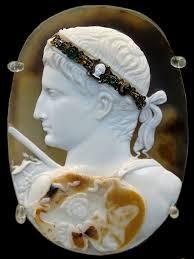
Cameo is a method of carving an object to create a three dimensional miniature sculpture. Typically, the darker colour will be in the background while the image in relief will be a lighter colour this is in contrast to an intaglio which has a negative image. Authentic carved cameos are made from natural materials like shell, agate, onyx, ivory, coral, mother-of-pearl, and various gemstones.
In ancient times cameos were mainly used for large earrings or signet rings, although the largest examples were just admired as pieces of art. Stone cameos of great artistry were made in Greece dating back as far as the 3rd century BC and they were very popular in Ancient Rome. The Greek and Roman empires created cameos featuring mythological scenes and important family members. Cameos served as status symbols as well as declarations of love.
Cameos have since enjoyed periodic revivals, particularly in the Renaissance, and again in the 18th and 19th centuries. The Neoclassical revival began in France with Napoleon’s support of the glyptic arts, and his coronation crown was decorated with cameos.
In Britain, this revival first occurred during King George III’s reign, and his granddaughter, Queen Victoria, was a supporter of the cameo trend, to the extent that they would become mass-produced by the second half of the 19th century.

Hand-carved cameos are guaranteed to be unique since no shell or piece of agate is same. The design is outlined in pencil, carefully carved, and then polished. This process requires immense control and skill, hence cameo artists following traditional techniques are few and far between these days.
There are many important facts to consider before giving a value to a cameo. The quality of the carving, the details of a cameo have to be precisely done. The rarity, age and condition. The frame and the material.





